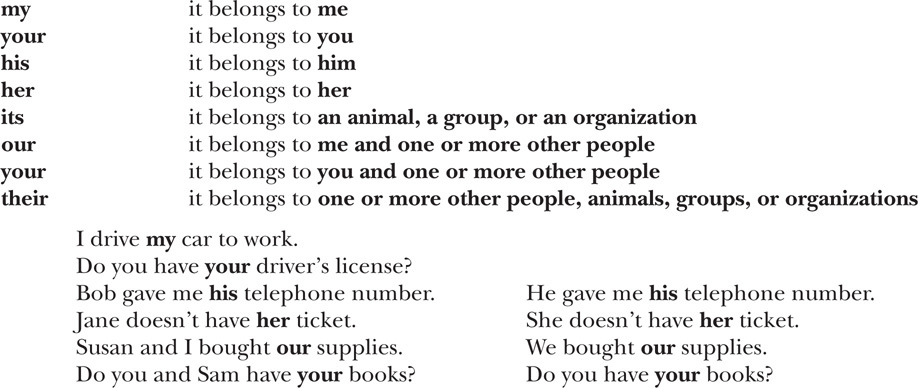Unit 4
Possessive Nouns and Pronouns
Possessive Nouns
A possessive noun indicates that the person, place, or thing named is the owner or holder of the noun that follows. It answers the question Whose … ? A possessive noun can be used before a singular noun, a plural noun, or a noncount noun.
It can be a proper noun followed by -’s:
Emily’s dress Bill’s shoes. Susan’s ice cream
A possessive noun can be a common noun followed by -’s:
the teacher’s desk the man’s glasses a friend’s mail
When two or more people own or have something, the plural noun is followed by an apostrophe if it ends in -s:
the teachers’ party the students’ books my friends’ health
If the plural form does not end in -s, it is followed by -’s:
the men’s cars the children’s class the people’s money
exercise 4-1
Write a phrase with a possessive noun for each item listed.
1. car/my sister _______________________________
2. hats/the men _______________________________
3. party/the children _______________________________
4. office/the doctor _______________________________
5. apartment/the girls _______________________________
6. class/Miss Smith _______________________________
7. school/Ben Lindsay _______________________________
8. meeting/the ladies _______________________________
exercise 4-2
Look at some photographs of your family and friends. Write five things you see, and indicate to whom they belong.
EXAMPLES: That’s Debbie’s dog.
Those are my sister’s shoes.
1. _________________________________________________________________________________
2. _________________________________________________________________________________
3. _________________________________________________________________________________
4. _________________________________________________________________________________
5. _________________________________________________________________________________
Possessive Pronouns
A possessive pronoun can be used in place of a possessive noun. A possessive pronoun can be used before a singular, plural, or noncount noun. These are the possessive pronouns:

exercise 4-3
Look at your answers to Exercise 4-1. Change the possessive nouns to possessive pronouns.
1. _________________________________________________________________________________
2. _________________________________________________________________________________
3. _________________________________________________________________________________
4. _________________________________________________________________________________
5. _________________________________________________________________________________
6. _________________________________________________________________________________
7. _________________________________________________________________________________
8. _________________________________________________________________________________
exercise 4-4
Look at your answers to Exercise 4-2. Change the possessive nouns to possessive pronouns.
1. _________________________________________________________________________________
2. _________________________________________________________________________________
3. _________________________________________________________________________________
4. _________________________________________________________________________________
5. _________________________________________________________________________________